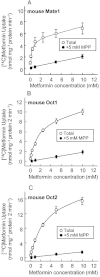Loss of multidrug and toxin extrusion 1 (MATE1) is associated with metformin-induced lactic acidosis
- PMID: 22242910
- PMCID: PMC3417438
- DOI: 10.1111/j.1476-5381.2012.01853.x
Loss of multidrug and toxin extrusion 1 (MATE1) is associated with metformin-induced lactic acidosis
Abstract
Backgrounds and purpose: Lactic acidosis is a fatal adverse effect of metformin, but the risk factor remains unclear. Multidrug and toxin extrusion 1 (MATE1) is expressed in the luminal membrane of the kidney and liver. MATE1 was revealed to be responsible for the tubular and biliary secretion of metformin. Therefore, some MATE polymorphisms, that cause it to function abnormally, are hypothesized to induce lactic acidosis. The purpose of this study is to clarify the association between MATE dysfunction and metformin-induced lactic acidosis.
Experimental approach: Blood lactate, pH and bicarbonate ion (HCO(3) (-) ) levels were evaluated during continuous administration of 3 mg·mL(-1) metformin in drinking water using Mate1 knockout (-/-), heterozygous (+/-) and wild-type (+/+) mice. To determine the tissue accumulation of metformin, mice were given 400 mg·kg(-1) metformin orally. Furthermore, blood lactate data were obtained from diabetic patients given metformin.
Key results: Seven days after metformin administration in drinking water, significantly higher blood lactate, lower pH and HCO(3) (-) levels were observed in Mate1(-/-) mice, but not in Mate1(+/-) mice. The blood lactate levels were not affected in patients with the heterozygous MATE variant (MATE1-L125F, MATE1-G64D, MATE2-K-G211V). Sixty minutes after metformin administration (400 mg·kg(-1) , p.o.) the hepatic concentration of metformin was markedly higher in Mate1(-/-) mice than in Mate1(+/+) mice.
Conclusion and implications: MATE1 dysfunction caused a marked elevation in the metformin concentration in the liver and led to lactic acidosis, suggesting that the homozygous MATE1 variant could be one of the risk factors for metformin-induced lactic acidosis.
© 2012 The Authors. British Journal of Pharmacology © 2012 The British Pharmacological Society.
Figures






Similar articles
-
Targeted disruption of the multidrug and toxin extrusion 1 (mate1) gene in mice reduces renal secretion of metformin.Mol Pharmacol. 2009 Jun;75(6):1280-6. doi: 10.1124/mol.109.056242. Epub 2009 Mar 30. Mol Pharmacol. 2009. PMID: 19332510
-
The L125F MATE1 variant enriched in populations of Amerindian origin is associated with increased plasma levels of metformin and lactate.Biomed Pharmacother. 2021 Oct;142:112009. doi: 10.1016/j.biopha.2021.112009. Epub 2021 Aug 11. Biomed Pharmacother. 2021. PMID: 34388523
-
Heterozygous variants of multidrug and toxin extrusions (MATE1 and MATE2-K) have little influence on the disposition of metformin in diabetic patients.Pharmacogenet Genomics. 2010 Feb;20(2):135-8. doi: 10.1097/FPC.0b013e328335639f. Pharmacogenet Genomics. 2010. PMID: 20016398 Clinical Trial.
-
Lactic acidosis induced by metformin: incidence, management and prevention.Drug Saf. 2010 Sep 1;33(9):727-40. doi: 10.2165/11536790-000000000-00000. Drug Saf. 2010. PMID: 20701406 Review.
-
A justification for less restrictive guidelines on the use of metformin in stable chronic renal failure.Diabet Med. 2014 Sep;31(9):1032-8. doi: 10.1111/dme.12515. Diabet Med. 2014. PMID: 24909998 Review.
Cited by
-
Trimethoprim-metformin interaction and its genetic modulation by OCT2 and MATE1 transporters.Br J Clin Pharmacol. 2013 Nov;76(5):787-96. doi: 10.1111/bcp.12079. Br J Clin Pharmacol. 2013. PMID: 23305245 Free PMC article. Clinical Trial.
-
Multidrug and toxin extrusion 1 and human organic cation transporter 1 polymorphisms in patients with castration-resistant prostate cancer receiving metformin (SAKK 08/09).Prostate Cancer Prostatic Dis. 2015 Jun;18(2):167-72. doi: 10.1038/pcan.2015.8. Epub 2015 Mar 10. Prostate Cancer Prostatic Dis. 2015. PMID: 25753371
-
Renal Drug Transporters and Drug Interactions.Clin Pharmacokinet. 2017 Aug;56(8):825-892. doi: 10.1007/s40262-017-0506-8. Clin Pharmacokinet. 2017. PMID: 28210973 Review.
-
The Effect of Nizatidine, a MATE2K Selective Inhibitor, on the Pharmacokinetics and Pharmacodynamics of Metformin in Healthy Volunteers.Clin Pharmacokinet. 2016 Apr;55(4):495-506. doi: 10.1007/s40262-015-0332-9. Clin Pharmacokinet. 2016. PMID: 26507723 Free PMC article.
-
Pharmacokinetic and pharmacodynamic interaction between gemigliptin and metformin in healthy subjects.Clin Drug Investig. 2014 Jun;34(6):383-93. doi: 10.1007/s40261-014-0184-3. Clin Drug Investig. 2014. PMID: 24627290 Clinical Trial.
References
-
- Bailey CJ, Turner RC. Metformin. N Engl J Med. 1996;334:574–579. - PubMed
-
- Ito S, Kusuhara H, Kuroiwa Y, Wu C, Moriyama Y, Inoue K, et al. Potent and specific inhibition of mMate1-mediated efflux of type I organic cations in the liver and kidney by pyrimethamine. J Pharmacol Exp Ther. 2010;333:341–350. - PubMed
Publication types
MeSH terms
Substances
LinkOut - more resources
Full Text Sources
Medical
Molecular Biology Databases

